Life
Cornelis Pietersz. Boom was the owner of an orchard and one of the five lanes on the Lastage to the east of Amsterdam. Boom, who lived at what is now the Rechtboomssloot numbers 1 to 3, had two ditches, the Rechtboomssloot and Kromboomssloot, widened into canals around 1530 to connect his shipyard on the Lastage with the IJ. Both canals are named after Boom. The Kromboomssloot thereby became a cross-channel from the main Rechtboomssloot canal. As the names indicate, the Rechtboomssloot is completely straight while there is a bend in the Kromboomssloot. The Lastage was outside the city walls at the time and was therefore under threat of attacks from the county of Guelders. When Boom was given permission to dig the canals, he had to allow the Rechtboomssloot to be closed in the event of danger, without the city having to pay compensation to Boom for this.
In 1537 Boom was allowed to demolish the quay for a slipway and to build a bridge over his ditch, now the Rechtboomssloot. In 1538 there was an impending attack by Guelders. The permit was revoked and Boom was ordered to pull down the bridge and close the gap again. That caused a battle between the city government, which wanted to block the ditch, and the people of Lastage who wanted a free passage. Boom litigated as high as the Hof van Holland (High Court) in Brussels to keep his canal open. In 1565, on the advice of William the Silent, the Court ruled that the gates should remain open on at least one side during the day, so that free movement by water remained possible. [1]
In 1542 the residents of the Lastage commissioned Cornelis Anthonisz. to draw a map of the city of Amsterdam, on which the area with its canals and buildings is clearly depicted. In 1543 it was rumored that Maarten van Rossum was approaching. The residents and owners on the Lastage asked Maria of Hungary for permission to enclose the Lastage. If necessary, they would pay the costs from their own pocket.
Boom had a house built that collapsed in 1545 due to the marshy subsoil. He asked for permission to start a shipyard on site where as many as five hundred people could find work.
1562 and 1564 were years of serious flooding, and the Rechtboomssloot was closed on one side. Boom felt he had been wronged. He and ten other Lastagians raised the matter with the Privy Council of the Habsburg Netherlands (Geheime Raad) in Mechelen, which referred the dispute to the Hof van Holland. The Lastagians then presented their case to William the Silent, who advised the Land Guardians ( voogd ) to decide in favor of the Lastagians. Governess Margaret of Parma decided on 6 August 1565 that the Rechtboomssloot should be opened to the Lastagians during the day. They could not derive any rights from the decision.
In 1567 the Duke of Alba arrived and took charge. [2] In 1576 he may have returned after the Pacification of Ghent.
Descendants
Boom's son Pieter Cornelisz. Boom was a councilor in 1580 and in 1582, and was mayor sixteen times from 1583 to 1608. In 1607 he was involved in the reclamation of Beemster, together with Dirck van Os and Jacob Poppen. [3]
Abraham Boom (1575 – 26 June 1642) married in 1599, was a member of the vro Gereedschap in 1609 and captain of the Schutterij (militia) in 1616. He is depicted in a painting of militiamen by Pieter Lastman. He was mayor from 1625 to 1639. In 1638 he and Albert Burgh, Antonie Oetgens van Waveren and Pieter Hasselaer received Marie de' Medici.
Boom's grandson Cornelis Abrahamsz. Boom (1601 – 22 August 1651) was a member of the Amsterdam council in the year of his death and at the same time was elected mayor, which was very unusual: a mayor was usually chosen from the sitting councilors. [4] He was the last male descendant of Boom.

Albert Coenraadsz. Burgh was a Dutch physician who was mayor of Amsterdam and a councillor in the Admiralty of Amsterdam.

Cornelis Corneliszoon van Haarlem was a Dutch Golden Age painter and draughtsman, one of the leading Northern Mannerist artists in the Netherlands, and an important forerunner of Frans Hals as a portraitist.

Andries Bicker was a prominent burgomaster, politician and diplomat in the Dutch Republic. He was a member of the Bicker family, who, together with the related De Graeff family, also local regents, governed the city of Amsterdam and with it the province of Holland for about half a century. At that time, the Republic was at the height of its power.

Cornelis Pietersz. Hooft was a Dutch statesman and Amsterdam regent during the Golden Age.

De Graeff is an old Dutch patrician and noble family,

Dirck Jansz Graeff, also Diederik Jansz Graeff, Lord of the manors Valckeveen and Vredenhof, was a patrician, wholesaler, shipowner, politician and large landowner. He became an important figure of the Protestant Reformation, member of the Reformed Church, supporter of the Geuzen and the Protestant-minded community of wholesale merchants, and a confidant of William I of Orange. Graeff was the founder of a regent dynasty of the Dutch Golden Age and the short time of the First Stadtholderless Period that retained power and influence for centuries and produced a number of ministers. He was the first Burgomaster of Amsterdam from the De Graeff family.

Cornelis Anthonisz., Anthonisz. also spelled Anthonissen or Teunissen, was a Dutch painter, engraver, and mapmaker.

Jacob Dircksz de Graeff, free lord of Zuid-Polsbroek was an illustrious member of the Dutch patrician De Graeff family. He belonged to States Faction and was an influential Amsterdam regent and burgomaster (mayor) of the Dutch Golden Age.

Lastage is a neighborhood in the Centrum borough of Amsterdam, Netherlands. It is located between the Geldersekade and Oudeschans canals, just east of old medieval city. Today, the neighbourhood is also known as Nieuwmarktbuurt due to the fact that the Nieuwmarkt is comprised in the area; it is protected as a heritage site.

Gerard Pietersz Hulft, was a Dutch general. In 1655 he was sent with a fleet to Ceylon and died in action.

Pieter Dircksz. Hasselaar was an Amsterdam brewer and schepen (alderman), and one of the founders of the Dutch East India Company. He is famous, along with his aunt Kenau Simonsdochter Hasselaer, for courageous actions during the siege of Haarlem in 1573. In 1578, after the Alteratie, he moved to Amsterdam and by 1583 was manager of the brewery of Andries Boelens. In 1587 he bought a brewery, the Eagle, between Nieuwendijk and Prins Hendrikkade.

The walls of Amsterdam were built in the Middle Ages to protect the city against attack. The Medieval walls were replaced with a series of bastions in the 17th century. In the 19th century, the walls were torn down and replaced with the Defence Line of Amsterdam, a fortification line which encircled Amsterdam at a distance from the city.

The Haarlem Bank van Lening is a former city Bank van Lening that has been converted to a restaurant in Haarlem, the Netherlands.

Nicolaes Lastman, was a Dutch Golden Age painter. According to the Netherlands Institute for Art History, he was the brother of Pieter Lastman and is sometimes mistakenly called "Claes Pietersz Lastman" as the son of Pieter. He is known for portraits, landscapes, and architectural studies. He started a large schutterstuk in Amsterdam that was later finished by Adriaen van Nieulandt.

The Voetboogdoelen was a 16th-century building on the Singel canal in Amsterdam, at the corner of Heiligeweg near Koningsplein square, which served as headquarters and shooting range of the local schutterij. Frans Hals painted a group portrait for the Voetboogdoelen, known as the Meagre Company.

The Rechtboomssloot, or Recht Boomssloot, is a canal in the Lastage (Nieuwmarktbuurt) neighborhood in the center of Amsterdam.

The Kromboomssloot, or Krom Boomssloot, is a canal in the Lastage (Nieuwmarktbuurt) neighborhood in the center of Amsterdam. It provides a transverse navigation from the Rechtboomssloot and was previously called Dwarsboomssloot. As the names indicate, the Rechtboomssloot is completely straight, while there is a curve in the Kromboomssloot.
This page is based on this
Wikipedia article Text is available under the
CC BY-SA 4.0 license; additional terms may apply.
Images, videos and audio are available under their respective licenses.




















